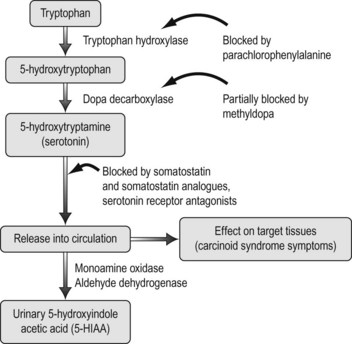147 Carcinoid syndrome
Salient features
Examination
• Listen to the chest for wheeze (bronchial carcinoid)
• Listen to the heart (right-sided murmurs in intestinal, gastric, hepatic and ovarian carcinoid, left-sided murmurs in bronchial carcinoid)
• Look for hepatomegaly (nodular and firm from metastases, may be pulsatile from tricuspid regurgitation).
Advanced-level questions
What are the cardiac lesions seen in metastatic carcinoid from the liver?
What are the types of gastric carcinoid?
Type I is associated with chronic atrophic gastritis.
Type II develops in patients with combined multiple endocrine neoplasia type 1 and the Zollinger–Ellison syndrome. (The multiple endocrine neoplasia type 1 gene locus may be involved in type II gastric carcinoid tumours.)
Note: Hypergastrinaemia has an important role in the development of types I and II.
How is the diagnosis confirmed?
How are these tumours treated?
• Emergency treatment includes prednisolone
• Severe diarrhoea: hydration, diphenoxylate with atropine, cyproheptadine or methysergide
• Octreotide (a somatostatin analogue) is associated with a significant reduction in 5-HIAA concentration
• Surgery is useful for localized carcinoid
• Chemotherapy in advanced disease (fluorouracil, streptozocin, dacarbazine)
• Interferon-α may be useful in those who do not respond to surgery and octreotide treatment (Digestion 1994;55(suppl 3):64–9).








